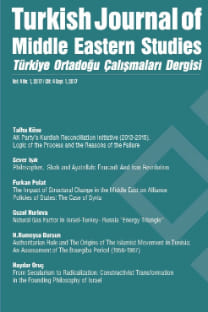Critique of ISIS’ Women Policy
Bu makalede IŞİD’in kadın politikası ele alınmaktadır. ISIS, kadınlarda yarattığı etkiyle, özellikle batıdan edindiği kadın militan sayısıyla diğer İslami örgütlerden farklılaşmaktadır. IŞİD’in kontrol ettiği topraklarda oldukça baskıcı ve barbar uygulamalarda bulunduğu bilinmesine rağmen kadınların IŞİD’e bu yoğunlukta katılımı dikkat çekmektedir. Bu nedenle, makalede kadınları IŞİD’e katılmaya iten gerekçelerle IŞİD’in kadınlara vaat ettikleri karşılaştırılmalı incelenmiştir. Bu incelemede, IŞİD’in kadın politikası devlet kurma sürecinde kadına yüklenen anlamlar ve kadınların bu süreci deneyimleme biçimi üzerine inşa edilmiştir. IŞİD’in kadın politikasını açıklamaya odaklanan makale, IŞİD ve kadın söz konusu olduğunda konuya İslam üzerinden yaklaşan araştırmaların tersine, konuyu devlet ve onun gender perspektifi üzerinden ele alarak oryantalist önyargılar taşıyan kültürcü bir söylemin ötesine geçme iddiası taşımaktadır.
Anahtar Kelimeler:
Manifesto, IŞİD, Kadın, Devlet Kurma Süreci, İslam
Critique of ISIS’ Women Policy
This article addresses the policy employed by ISIS with respect to women. ISIS differs from other Islamic organisations in terms of its impact on women and specifically, the number of female militants it has recruited from the West. Such high numbers of women joining ISIS is striking when considered in the face of the fact that ISIS is well known to be involved in rather oppressive and barbaric practices in territories under its control. Therefore, the article examined the reasons that trigger women to join ISIS and the promises of ISIS for women. The present review builds the policy employed by ISIS with respect to women upon the meanings attributed to women in the founding process of a state and the manner in which women experience this process. Focused on the policy employed by ISIS with respect to women, the article carries on the claim of extending beyond a cultural discourse inflicted with orientalist prejudices by addressing the matter from the perspective of the state and its gender perspective in contrary to research studies approaching ISIS and women from an Islamic standpoint.
Keywords:
ISIS, Women, Manifesto, State Building Process, Islam,
___
- Referans 1 Akgül, Ç. (2013). “Milliyetçi Söylemin Her Dem “Poine”si: Savaş Tecavüzleri.” Alternatif Politika, 5/1, 91-113. ISSN: 1309-1593.
- Referans 2 Al-Faras, Z. (2015, March 13). “Isis: British schoolgirls set to join the sinister al-Khansa brigade in Syria”. Retrieved from http://www.ibtimes.co.uk/isis-british-schoolgirls-set-join-sinister-al-khansa-brigade-syria-1491772, (Accessed: 26 June 2016).
- Referans 3 Azad, N. (2015, April 22). “ISIS kidnapped 3 thousand women in Iraq”. Retrieved from http://www.nerinaazad.com/news/regions/middleeast/isid-irakta-3-bin-kadin-kacirdi, (Accessed: June 24, 2016).
- Referans 4 Begum, R., & Muscati, S.. (2015, April 15). “Interview: These Yezidi Girls Escaped ISIS. Now What?”. Retrieved from https://www.hrw.org/news/2015/04/15/interview-these-yezidi-girls-escaped-isis-now-, (Accessed: August 18, 2016).
- Referans 5 Boehmer, E. (1991). “Stories of women and mothers: gender and nationalism in the early fiction of Flora Nwapa”. In Susheila Nasta (Eds), Motherlands: Black Women’s Writing from Africa, the Caribbean and South Asia. (pp. 3-23). London: The Women’s Press.
- Referans 6 Brownmiller, S. (1975). Against Our Will: Men, Women and Rape. New York: Simon and Schuster.
- Referans 7 Chatterjee, P. (1986). Nationalist Thought and the Colonial World: A Derivate Discourse. Londra: Zed.
- Referans 8 Enloe, C. (2000). Maneuvers: The International Politics of Militarizing Women Live. Berkeley: University of California. Referans 9 “Avrupalı Kadın Üyeler için IŞİD’e yolculuk ‘tek yön’”. (2015, May 28). Retrieved from http://tr.euronews.com/2015/05/28/avrupali-kadin-uyeler-icin-isid-e-yolculuk-tek-yon/.
- Referans 10 Frej, W. (2014, October 25). “ISIS Female: Why women are drawn to join”. Retrieved from http://www.msnbc.com/ronan-farrow-daily/isis-female-why-women-are-drawn-join, (Accessed: June 3, 2016).
- Referans 11 Goldstein, J. S. (2001).War and Gender: How Gender Shapes the War System and Vice Versa, Cambridge: Cambridge University Press.
- Referans 12 Hoyle, C., Bradford, A. & Frenet, R. (2015). Becoming Mulan: Female Western Migrants to ISIS. Institute for Strategic Dialogue. Retrieved from: http://www.strategicdialogue.org/ISDJ2969_Becoming_Mulan_01.15_WEB.PDFBecoming Mulan. (Accessed: September 12, 2016).
- Referans 13 Human Rights Watch. (2012). Torture Archipelago: Arbitrary Arrests, Torture and Enforced Disappearance in Syria’s Underground Prisons Since March 2011. USA: HRW. Retrieved from: http://www.hrw.org/sites/default/files/reports/syria0712webwcover.pdf, (Accessed: July 13, 2016).
- Referans 14 Nagel, J. (2004). “Erkeklik ve Milliyetçilik: Ulusun İnşasında Toplumsal Cinsiyet ve Cinsellik”. In . Ayşe Gül Altınay (Eds.), Vatan, Millet, Kadınlar, İstanbul: İletişim Yayınları.
- Referans 15 Shubert, A.,& Naik, B. (2014, September 10). “From Food Recipes to AK-47s: Inside Online World of the Women of ISIS”, Retrieved from http://edition.cnn.com/2014/09/10/world/meast/iraq-syria-isis-women, (Accessed: July 3, 2016).
- Referans 16 Taub, A. (2015, February 18). “No, CNN, women are not joining ISIS because of ‘kittens and Nutella’”. Retrieved from http://www.vox.com/2014/10/20/6987673/isis-women, (Accessed: July 1, 2016.)
- Referans 17 Trew, B. (2016, February 29). “ISIS sends women into battle in Libya”. Retrieved from http://www.thetimes.co.uk/tto/news/world/middleeast/article4701536.ecex, (Accesed: March 2, 2016).
- Referans 18 Yuval Davis, N.,& Anthias, F. (1989). Woman-Nation State. Londra: M
- ISSN: 2147-7523
- Başlangıç: 2014
- Yayıncı: Sakarya Üniversitesi Ortadoğu Enstitüsü adına Ali Balcı
Sayıdaki Diğer Makaleler
Gendering Migration Across Euro-Mediterranean Borders: Syrian refugee women on the way to the Europe
Theocratic Democracy: The Social Construction of Religious and Secular Extremism
Rejim Güvenliği ve Tunus Dış Politikası
Fransa’nın Arap Baharı Politikası
